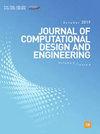采用HSV色彩空间和图像处理技术的工业缝纫机断线检测系统
IF 6.1
2区 工程技术
Q1 COMPUTER SCIENCE, INTERDISCIPLINARY APPLICATIONS
引用次数: 1
摘要
缝制缺陷检测是服装生产质量控制的重要环节。虽然缝纫缺陷对服装质量影响很大,但与面料缺陷相比,缝纫缺陷还没有得到广泛的研究。在本研究中,为了解决缝制缺陷检测问题,并为小型和劳动密集型服装公司开发合适的方法,提出了一种机器上的断缝检测系统。在硬件方面,一个多功能的安装套件,包括夹紧,显示,和可调的联动相机,提出了方便安装在典型的工业缝纫机和放置相机靠近缝纫位置。此外,一个原型是使用低成本的单板计算机,树莓派4b,它的相机,和Python语言实现的。针对自动断线检测,提出了一种基于去除背景织物纹理、HSV色彩空间图像处理和边缘检测的方法,在各种织物和纱线颜色及光照条件下实现鲁棒断线检测。该系统具有较高的实时检测精度。在包含880幅图像和各种工业缝纫机现场测试的缝纫缝线数据集上,获得的最大准确率为82.5%,比现有两种方法提高了12.1-34.6%。本文章由计算机程序翻译,如有差异,请以英文原文为准。
Broken stitch detection system for industrial sewing machines using HSV color space and image processing techniques
Sewing defect detection is an essential step in garment production quality control. Although sewing defects significantly influence the quality of clothing, they are yet to be studied widely compared to fabric defects. In this study, to address sewing defect detection and develop an appropriate method for small and labor-intensive garment companies, an on-machine broken stitch detection system is proposed. In hardware, a versatile mounting kit, including clamping, display, and adjustable linkage for a camera, is presented for easy installation on a typical industrial sewing machine and for placing the camera close to the sewing position. Additionally, a prototype is implemented using a low-cost single-board computer, Raspberry Pi 4 B, its camera, and Python language. For automated broken stitch detection, a method is proposed that includes removing the texture of the background fabric, image processing in the HSV color space, and edge detection for robust broken detection under various fabric and thread colors and lighting conditions. The proposed system demonstrates reasonable real-time detection accuracy. The maximum accuracy obtained on a sewing stitch dataset with 880 images and on-site tests of various industrial sewing machines is 82.5%, which is 12.1–34.6% higher than that of the two existing methods.
求助全文
通过发布文献求助,成功后即可免费获取论文全文。
去求助
来源期刊

Journal of Computational Design and Engineering
Computer Science-Human-Computer Interaction
CiteScore
7.70
自引率
20.40%
发文量
125
期刊介绍:
Journal of Computational Design and Engineering is an international journal that aims to provide academia and industry with a venue for rapid publication of research papers reporting innovative computational methods and applications to achieve a major breakthrough, practical improvements, and bold new research directions within a wide range of design and engineering:
• Theory and its progress in computational advancement for design and engineering
• Development of computational framework to support large scale design and engineering
• Interaction issues among human, designed artifacts, and systems
• Knowledge-intensive technologies for intelligent and sustainable systems
• Emerging technology and convergence of technology fields presented with convincing design examples
• Educational issues for academia, practitioners, and future generation
• Proposal on new research directions as well as survey and retrospectives on mature field.
 求助内容:
求助内容: 应助结果提醒方式:
应助结果提醒方式:


